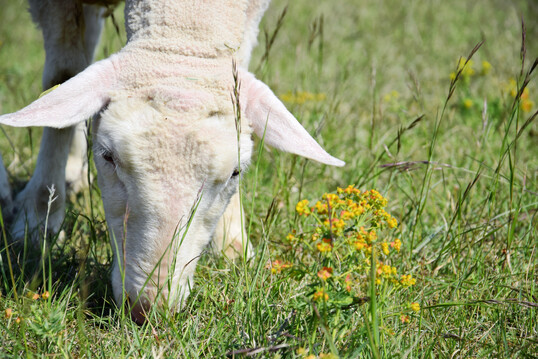
Forests caught between climate protection and resource provision
This article analyzes conflicts between climate protection, forestry, and the timber industry in Germany’s forests. The fact that the latter have transformed from a CO2 sink into a CO2 source in recent years is an obstacle for achieving binding EU and national climate protection targets. According to these legal obligations, forests are to remove large amounts of CO2 from the atmosphere and store it for long-term. This important aspect of the so-called LULUCF mechanism is presented in detail. The reasons for the loss of the sink function are: (1) increasing climate change-related forest damage, in particular the dieback of mature spruce forests with subsequent timber harvesting; (2) the use of approximately 50% of the annual timber yield for energy; (3) a generally very intense level of forest utilization; (4) the comparatively low sequestration of carbon in long-living wood products; and (5) the significant decline in forest growth, also caused by climate change. Based on the analysis, the inclusion of wood as a climate-neutral energy source in the EU Renewable Energy Directive (RED III) is criticized, and consequences for forestry practices and forest policy management are discussed. Necessary changes in the LULUCF (forest) sector also include options for fulfilling obligations resulting from the EU Nature Restoration Law. Submitted on 18.12.2024, accepted on 30.3.2025.
von Rainer Luick, Eckhard Jedicke, Thomas Fartmann, Manfred Grossmann, Pierre L. Ibisch, Thomas Potthast and Josef Settele erschienen am 29.04.2025 DOI: 10.1399/NuL.127969Dieser Beitrag ist auch in deutscher Sprache verfügbar: www.nul-online.de, DOI:10.1399/NuL.127958.
1 Introduction and research question
Article 1 of the 1992 United Nations Framework Convention on Climate Change (UNFCCC) emphasizes the importance and role of natural CO2 reservoirs and sinks in tackling global climate change; these are primarily forests, peatlands and extensively used grasslands (UNFCCC 1992). Preserving and restoring these ecosystems is one factor influencing how drastic climate change will be. How should the situation regarding forests be assessed and what action needs to be taken as a result?
This article summarizes important facts on this topic. More detailed information on the state of utilization and the ecological situation of forests from a global, European and national perspective is compiled in an online supplement (webcode NuL2231).
The global forest area currently covers around 3.7 billion hectares, of which around 1 billion hectares are still considered primary forests. Added to this are forest plantations with around 300 million ha. Around 1950, there were still an estimated 5 billion hectares of primary forests. If the losses of primary forests are offset against ‘new’ forest areas (mainly succession and afforestation of rangelands and plantations), global forest losses have decreased slightly in recent decades. However, the loss of primary forests has continuously accelerated since 1990. In the decade 2010-2020, an average of around 35.5 million hectares were destroyed each year. In the EU countries, compared to the baseline of the 1950s, both forest areas and wood stocks have developed significantly in a positive direction, although stocks (not forest area) have declined again in recent years (Ceccherini et al. 2020, Clarke et al. 2022, EFI 2023, Estoque et al. 2022, FAO & UNEP 2020, GFW 2024, OWD 2024, STATISTA 2024 WWF 2011).
In addition to legal and illegal deforestation, the dramatic increase in forest fires is a relevant factor. The main cause is now climate change. Between 2001 and 2023, around 140 million hectares of forests were burnt worldwide, including around 70 million hectares between 2016 and 2023 alone. For the year 2023, around 7.7 billion tons of CO2 emissions were attributed to global forest fires, which corresponds to a share of around 22% of the 35 billion tons of total CO2 emissions from all sectors worldwide (IPCC 2021, Jones et al. 2024, OWD 2025, STATISTA 2025, WRI 2024).

In the context of climate protection efforts, it is extremely problematic that global forest ecosystems have, for around 20 years now, no longer been CO2 sinks. The Global Carbon Project’s Budget Report 2023 states that globally, only around half of emissions from forest loss are now offset by CO2 uptake in forests (Friedlingstein et al. 2023). The calculation and reporting of greenhouse gas (GHG) emissions, GHG inventories and creditable emission reductions follows internationally binding standards. The Land Use, Land Use Change, and Forestry (LULUCF) sector was defined for the complex of natural sinks, reservoirs and sources of GHG (for historical development see: UBA 2016). The other sectors that are accounted for, and must be reported on, are energy, industry, buildings, transport, agriculture and waste management.
For the EU, the recording and reporting obligations for the LULUCF sector were set out in a regulation that was amended several times, most recently in 2023 (LULUCF Regulation (EU) 2023/839, EU 2013, 2018, 2023), and thus also incorporated into the EU Climate Change Act and the Federal Climate Change Act (“Klimaschutzgesetz” = KSG), most recently in KSG (2024). The revised LULUCF Regulation, which came into force on 11 May 2023, covers two periods (2021-2025, 2026-2030) with binding targets for the member states (European Council 2023, DNR 2024):
- In the first period up to 2025, the rule applies that GHG emissions must not exceed the commitment in the overall sector (‘no-debit rule’).
- In the period 2026-2030, the sector must achieve a growing net GHG sink in order to meet the EU’s overall target for reducing GHG emissions (57% reduction by 2030); reductions must amount to at least 310 million tons of CO2 eq. by that time. To this end, each member state was given binding national targets, which are set out in the regulation. The linear target path began in 2022 with the average value of the country-specific GHG inventory data or projections for the years 2021-2023 and initially ends in 2030 at least at the target set for the respective country, for Germany at least -25 million tons of CO2 eq.
- Member states must set out in their National Energy and Climate Plans (NECP) how they intend to achieve the national targets. The German NECP was submitted to the EU on 29 August 2024 (EC 2024a).
In light of this, the present article discusses the following questions:
- What consequences do current developments in the forestry sub-sector of LULUCF have for the agreed climate protection targets?
- How can the LULUCF targets for forests be achieved in combination with other societal goals, such as the implementation of the EU Nature Restoration Law (NRL)?
To this end, facts and figures on the situation of forests and the forestry sector as part of the LULUCF sector in climate protection and political decisions on their use as a supposedly climate-neutral resource are analyzed and critically scrutinized. Necessary action in the LULUCF (forest) sector is also important for the fulfilment of obligations resulting from the EU Nature Restoration Law (NRL) (EU 2024; see Luick et al. 2025 a, b). Such sector coupling in implementation is essential to achieve synergies.
The social benefits expected from forests must not be reduced to climate protection and timber production: The German Federal Forest Act (BWaldG) ascribes equal value in principle to utilization, protection and recreational functions (Section 1 (1) BWaldG). In our understanding, this guiding principle of multifunctionality also addresses the diverse ecosystem services of forests (see also Deutscher Bundestag 2024 a, Wirth et al. 2015).

2 The LULUCF sector in a forestry context
2.1 LULUCF - a key factor in climate protection
In the LULUCF sector (see section 1), GHG emissions (sources) and CO2 sequestration (sinks) are calculated together. In contrast to the other sectors, there is no cross-sectoral offsetting and separate emission targets are set.
The LULUCF situation in Germany is as follows. The most significant CO2 sources are agricultural soils, especially drained organic soils, drained and denatured wetlands such as peatlands, and losses of tree biomass and forests. A sink occurs when natural or anthropogenic processes and activities cause more CO2 emissions to be sequestered than GHGs to be emitted. By far the largest sink is (or, as will be shown below, was) the carbon sequestration in the forest in the above-ground biomass, in deadwood and in the soil (see also the timeline up to 2018 in Fig. 1). In temperate forest ecosystems, over 50 % of the sequestered carbon lies in the forest soils (BMEL 2024, Luick et al. 2021, 2022, among others). Carbon and humus-rich soils are also extremely important for forest vitality. Soil protection and soil regeneration therefore play a central role for the forest sink. In addition to these (potential) sink services and the resulting storage, the LULUCF sector also includes long-life wood products that store carbon in the wood product for a definite product-specific period.
![Fig. 1: Timeline of greenhouse gas emissions (sum of CO
<sub>2</sub>
, CH
<sub>4</sub>
and N
<sub>2</sub>
O in [million tons of CO
<sub>2</sub>
eq.]) in the LULUCF sector 1990-2023, taking into account the results of BWI 4, broken down by land use category; positive values: source; negative values: sink (Gensior et al. 2025).](https://www.nul-online.de/vorlagen/webapp/cache/cms/128348_haytinrrgy4a-540x345.jpg)
Achieving greenhouse gas neutrality requires a pronounced negative GHG balance in the LULUCF sector, which can only be achieved through high and continuous carbon sequestration in forests and long-lved wood products. This is because it is unrealistic that there will be any significant reduction in GHG emissions from the land use sub-sector – which essentially means current agricultural practices. This also applies to Germany and is unlikely to change significantly as a result of ‘carbon farming’ methods. Although the positive effects of these methods have been proven, they are rarely implemented in practice. These include: (1) the build-up of humus through soil-conserving cultivation methods; (2) crop rotations that promote arable soil regeneration; (3) cultivation of plants with strong root penetration; (4) consistent undersowing in the crop and greening after harvest; (5) agroforestry systems and (6) the introduction of biochar or, more generally, carbon into the soil, for example from the pyrolysis of wood biomass from landscape management or its composting (e.g. BMEL 2023, ENVI 2021, Scheid et al. 2023).
For the forestry sub-sector, the LULUCF Regulation stipulates that each EU member state must submit a National Forestry Accounting Plan for the periods 2021-2025 and 2026-2030 as the basis for accounting. This must contain the so-called Forest Reference Level (FRL), against which the real changes in the forest in the respective period are balanced and calculated. The FRL for Germany for the period 2021-2025 was calculated with an annual sink of 34.4 million tons of CO2 eq. It is essentially derived from the findings of the Federal Forest Inventory 3 from 2012 (BMEL 2018) and the carbon inventory from 2017 (see BMEL 2019, Rock et al. 2021).
This figure was the reason why Germany, in order to fulfil its obligations under the Federal Climate Protection Act (KSG), the EU Climate Change Act and the Paris Climate Agreement, has already assigned high levels of performance to the LULUCF sector for the period up to 2025, which go far beyond climate neutrality (‘no debit’). Forests in particular (and to a lesser extent peatlands) are to compensate for the unavoidable (residual) emissions of other economic sectors in future by absorbing significantly more CO2.
In the most recently amended version of the KSG in 2024, the following climate targets are set out in Section 3a: from 2027 to 2030, the LULUCF sector is to provide an annual emissions balance of at least -25 million tons of CO2 eq., from 2037 to 2040 -35 million tons and from 2042 to 2045 -40 million tons of CO2 eq. (German Federal Government 2024 a, UBA 2024 a). The measures envisaged include: (1) increasing the forest area, (2) carbon forestry strategies, i.e. adapting the management of existing forests with the aim of storing a higher carbon stock, and (3) further building up the carbon stock by increasing the use of long-life wood products.
This legislative decision was made on the basis of forestry evidence and expertise and the expectation that the sink and storage capacity of forests and material wood products will remain high and can even be increased – although findings, including from carbon inventories, have long signaled a significant decline in the GHG sink capacity of forests (including TI 2024, UBA 2023 a).
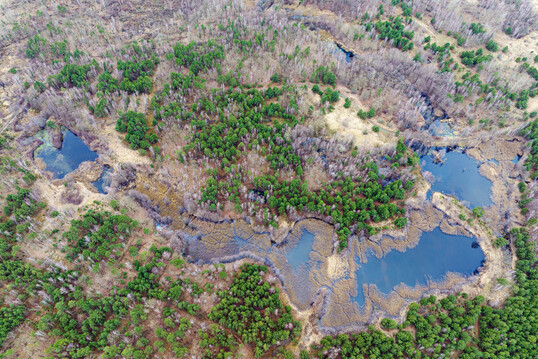
2.2 Findings of the National Forest Inventory 4 and effects on expected climate protection services
The findings of the National Forest Inventory (BWI - “Bundeswaldinventur”) 4 published on 8 October 2024 (BMEL 2024, see also Text Box 1) and their inclusion in the calculation of the 2025 greenhouse gas inventory, including re-calculations for previous years, required a drastic correction of the GHG balances for the LULUCF sector for the years from 2018 onwards. Instead of a cumulative (moderate) net CO2 source of +13.2 million tons of CO2 eq. for the years 2018-2023 (UBA 2024 d), the BWI-4 data now shows emissions of +439.40 million tons of CO2 eq., which is 35 times higher (Gensior et al. 2025, UBA 2025a; see Fig. 1, Tab. 1).
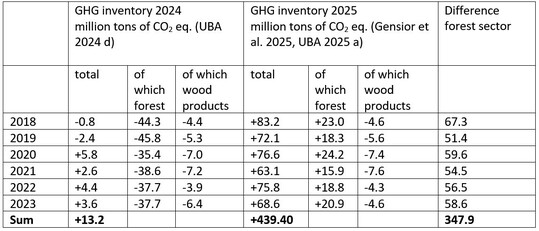
These new figures correspond to around 8% of total annual GHG emissions (excluding LULUCF) in Germany for 2021, around 10% for 2022 and also around 10% for 2023. This poses a major problem for Germany in terms of achieving the CO2 emission reduction targets, both in the context of the sink targets of the EU LULUCF Regulation and the KSG and in relation to overall climate protection targets.
In January 2025, the European Environment Agency presented its monitor report (EEA 2025): According to this report, there is no discernible trend in the central LULUCF sector (based on figures of 2022) that suggests the annual mitigation target of -310 million tons of CO2 eq. is achievable by 2030. The figure given for 2022 is -236 million tons of CO2 eq. (Fig. 2). It does not take into account the +56.6 million tons of CO2 eq. for the year 2022 in current German GHG reporting, so that the true figure, including the German share alone, is circa -179 million tons of CO2 eq. The projection for 2030 is currently around -180 million tons of CO2 eq. or only around -120 million tons of CO2 eq. if an assumed carbon-source figure for Germany of around +60 million tons of CO2 eq. is added. Even without taking current data for the years 2017-2022 into account, it is therefore clear that the agreed mitigation target of at least -310 million tons of CO2 eq. per year for 2030 is far beyond reach. It is also clear that the sink capacity of forests is already declining dramatically for the 2017-2022 accounting period.
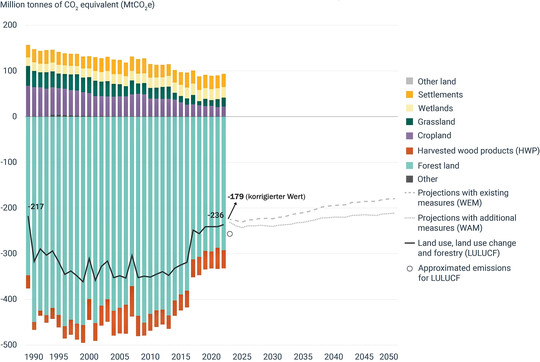
The explanation lies in the forestry sub-sector: in order to fulfil national, European and global Paris Agreement climate targets, an annual sink of -34.4 million tons of CO2 eq. was calculated for this sub-sector for the period 2021-2025 in accordance with the Forest baseline assumed. However, this assumed sink has now developed into a significant source. The causes are
- increasing forest damage due to climate change, in particular the death of age-class spruce forests with subsequent timber utilization and the associated large-scale traffic when clearing damaged timber in clearcuts as a result of drought damage and associated calamities (Gensior et al. 2024); according to the BWI 4, around 2 million hectares are affected, on which the tree stands are damaged and in some cases completely dead; since 2017, the stock of spruce trees has fallen by 18.2 % (BMEL 2024);
- the utilization of around 50 % of the annual wood supply for energy (see Section 3 and Luick et al. 2022);
- a generally very intense utilization of forests (TI 2024, UBA 2024f);
- the comparatively low fixation of carbon in long-lived wood products (BMEL 2024);
- the significant decline in forest growth, also due to climate change (total wood stock growth in BWI 4 across all tree species 9.4 m3/ha/a = -16 % compared to BWI 3; BMEL 2024).
As a reminder: according to Section 3a KSG, the LULUCF sector is to achieve sink performance of -25, -35 and -40 million tons of CO2 eq. in the target years 2030, 2040 and 2045, respectively.
The further effects of this new evidence can be seen in Fig. 3: Based on the BWI-3 data from 2012 and data from the GHG inventory, forecasts for future emissions trends for the LULUCF sector were modelled last year for the annual targets 2030, 2040 and 2045 (UBA 2024 a, b; dotted lines in Fig. 3; see also Fig. 2, timeline up to 2017). In the new projection data (TI 2025, Fig. 3, solid lines), the GHG emissions of the LULUCF sector are adjusted based on the BWI-4 data. It is clear that the sector will release significantly more CO2 in the long term than previously assumed. Even in the with-measures scenario (see following paragraph), emissions are far from achieving the targets of the Climate Protection Act.
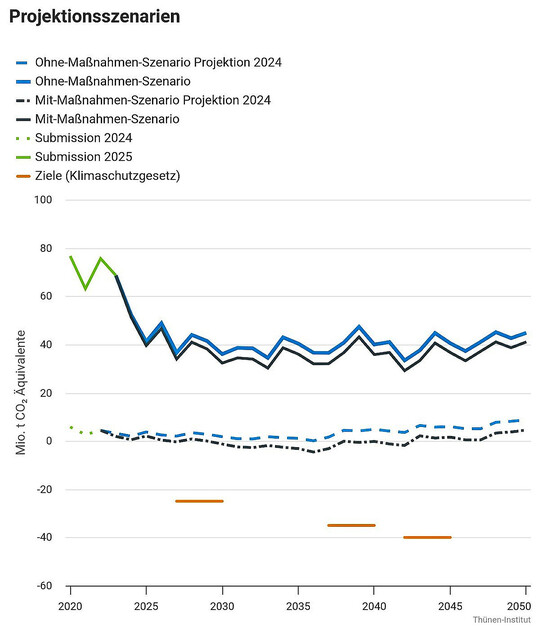
In this context, the comprehensive study presented by the German Federal Environment Agency (UBA) in December 2024 on planned climate protection instruments for all sectors, with which the greenhouse gas projections for 2025 are modelled, is also significant. A distinction is made between the Mitigation Measures Scenario (MMS), which includes measures that have already been adopted and largely implemented, and the Mitigation Further Measures Scenario (MFMS), which includes additional planned but not yet implemented measures (Hennenberg et al. 2024, UBA 2024 c, see also Fig. 3). In the LULUCF sector, the basic assumption was an expected reduction in forest sink capacity. According to the scenarios, active forest support measures (MMS and MFMS measures) would have enabled further moderate sink performance if appropriate programmes had been available, even if not achieving the range of figures agreed in the KSG.
With the new data on the condition of forests, these projection data and targets are now largely obsolete. It is even utopian to think that the ‘no-debit’ minimum target for 2025 from the LULUCF Regulation can be met. The biennial report of the Expert Council on Climate Change presented in February 2025 states (ERK 2025):
- There is a high risk of further increases in emissions from forests in the future, as extreme and disruptive events such as storms, drought and pest infestations, which can place a heavy burden on the forest ecosystem, continue to increase as a result of climate change.
- It is quite impossible that the LULUCF sector will be able to achieve its first interim target of a sink capacity of -25 million tons of CO2 eq. in 2030. In total, with emissions remaining high and presumably continuing to rise (70-80 million tons of CO2 eq. per year), an additional annual sink of 100 million tons of CO2 eq. will very soon have to be shouldered by other sectors.
- In the LULUCF sector, impacts from quantified measures from the Natural Climate Protection Action Programme have already been accounted for in the coming years, although their positive climate impact is considered to be overestimated.
Irrespective of the LULUCF figures, the German Federal Environment Agency estimates that Germany has a realistic chance of achieving its climate protection targets with a 65% reduction in emissions by 2030 compared to 1990 levels if current climate policy instruments continue to be implemented consistently (UBA 2025 b). At the same time, the gap between the status quo and the targets set out in the EU Climate Protection Regulation is widening, particularly due to insufficient success in the transport and buildings sectors. However, the LULUCF sector is not included in these assessments due to its special position (see introduction to section 2.1).
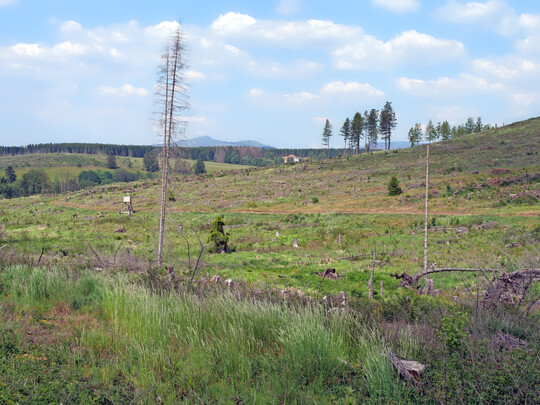
2.3 Action or new interpretative models?
In our opinion, the implications of this data are serious for the new forestry policy framework that is required, which would then also have paradigmatic effects on forest economics and forest management and the design of relevant instruments. Unlike the reasonable and feasible recommendations for measures published by the Federal Environment Agency in December (UBA 2024 c), this is because only radical measures with completely different economies of scale are now capable of having a corrective influence on the LULUCF sector. In addition to a massive increase in funding in the Natural Climate Action Programme (ANK - Aktionsprogramm Natürlicher Klimaschutz), the implementation of the NRL (which also requires solid independent financing) can make a significant contribution to this (Luick et al. 2025 b). It is possible that the decisive lever for action will be the commitment of the German government to improve (compliance with) the emission targets in the LULUCF sector (see sections 1 and 2.4).
The recent paradigm shift in forestry policy and in forestry and timber industry circles is remarkable. Until a few years ago, there was a narrative of sustainable forestry that promotes climate protection, based on the almost unlimited ‘supply capacity’ of forests for wood that can be used for material and energy purposes while at the same time building up stocks (e.g. Federal Government Forest Report 2017, German Federal Government 2017). In evaluating the results of the BWI 4, the Scientific Advisory Council for Forest Policy (WBW – Wissenschaftlicher Beirat für Waldpolitik) at the Federal Ministry of Food and Agriculture (BMEL) now describes the target goals for the LULUCF sector formulated in the KSG as ‘too ambitious’ (WBW 2024). ‘To avoid permanently pursuing unrealistic targets, these should be reviewed and adjusted on the basis of coordinated scenarios and suitable models, taking uncertainty into account’ and the LULUCF sector ’should be included in the cross-sectoral overall calculation and aggregated consideration’ of the KSG.
In its position paper for the 2025 federal election, the Association of German Forest Owners (AGDW) called for the LULUCF Regulation and the German KSG to be urgently amended. Specifically, the stipulated sink and storage capacities (wood stocks) of forests should be significantly reduced in order to allow the current level of wood utilization to continue (AGDW 2025 a) – a view that calls into question not only the national legal situation, but also binding obligations under international law. Even after publishing its statement, the AGDW is still promoting the ‘Forest is a climate protector’ initiative it supports (AGDW 2025 b): “Our forest binds 8 tons of CO2 per year and hectare”. The initiative also proclaims: “The forest is Germany’s most important climate protector! With more than 127 million tons of CO2 (including wood use), it binds 14% of the annual CO2 emissions of the German economy”.
It is indisputable and even inevitable that the baseline for forests will have to be significantly adjusted for the period 2026-2030 due to the new systemic conditions. This will not change the GHG emissions from the forest system or the statutory targets, but the accounting system will at least be recalibrated.
The Federal Forest Inventory (BWI = “Bundeswaldinventur”) is a legal mandate in accordance with Section 41a of the Federal Forest Act (BWaldG) and provides a central database on the condition of our forests. Inventories have been carried out four times so far: 1987, 2002, 2012 and 2022. Since 2010, a ten-year repeat cycle has been stipulated by law. The BWI is supplemented by the carbon inventory surveys based on a sub-sample of the BWI, which has been carried out twice so far (2008 and 2017). The BWI is based on the terrestrial survey and evaluation of around 80,000 systematically distributed grid areas across Germany. The most important findings of BWI 4 (based on 2022 data; BMEL 2024, WBW 2024) are as follows:
- As of 2022, the forest in Germany has a timber stock of 3.7 billion m3 or an average of 335 m3/ha. This is a slight decrease compared to 358 m3 from BWI 3.
- Compared to BWI 3 (1), growth has decreased by around 16 % to 9.6 m3/ha per year; (2) the area of deciduous trees increased by 7 % and the proportion of spruce decreased by 17 %; (3) the amount of deadwood increased by approximately 30 % to 29.4 m3/ha; (4) the proportion of trees with a diameter at breast height > 50 cm increased by 22 %.
- Compared to the 2017 carbon inventory, the stock of wood has decreased by 220 million m3 or 18.2 %. Overall, the carbon stock in the forest has decreased by 41.5 million tons (-3 %).
- In the case of an important parameter of semi-natural forests, the trees with ecologically significant features (microhabitats such as hollows, mushroom colonies or crown deadwood), there was no change to the low initial value.
- The ecological condition of publicly owned forests is better than that of forests owned privately, although smaller private forests are still in a significantly better ecological condition overall than large private forests. The latter are largely categorized as less close to a natural condition.
- There is still no fundamental trend reversal in the ratio between deciduous forests and coniferous forests; only in public forests do deciduous trees now predominate over coniferous.
It is not only in Germany that the LULUCF sector has developed in a problematic direction, as the EU member states as a whole lost around a quarter of their forest stocks, which reduced sink effects in the period 2002-2020; more recent analyses are not yet available. The most important driving forces behind these developments are identical to the situation in Germany: (1) the effects of forest damage caused by climate change, (2) excessive harvest volumes and (3) the sharp increase in the use of fresh wood for energy purposes, which is then immediately counted as a GHG emission in the balance sheet and can no longer contribute to building up a long-life product store. Dramatic developments, including the complete loss of the sink services of their forests, can be seen in the following countries: Austria, Belgium, Bulgaria, Croatia, the Czech Republic, Denmark, Estonia, Finland, France, Ireland, Lithuania, the Netherlands, Portugal and Slovenia. New data for Sweden show a rapid decline in the forest carbon sink due to the expansion of harvested areas; in Finland, the decline in the forest sink is also attributed to the massive increase in the direct use of stem wood for energy (Camia et al 2022, Hennenberg et al. 2022, PFPI 2022).
However, it is possible that these developments will have no legal consequences for the EU countries, as the LULUCF Regulation also contains numerous legal options for justifying why CO2 reduction targets were not met, for example if compliance was prevented by natural, random disturbances and the effects of climate change and if this can be backed-up by evidence.
2.4 The climate protection services of the forest on trial
In May 2024, a landmark judgement was handed down in a lawsuit brought by Deutsche Umwelthilfe (DUH) against the German government before the Berlin-Brandenburg Higher Administrative Court (DUH 2024, BVRDB 2024): DUH sued for compliance with the EU Climate Protection Regulation and explicitly the LULUCF Regulation. One of the grounds for the lawsuit was that Germany would face annual fines in the double-digit billion range from 2030 for the purchase of emission allowances from other EU countries, if the legally binding EU climate protection requirements were not met.
The Higher Administrative Court of Berlin-Brandenburg largely agreed with the grounds of the complaint and ruled that
- The Federal Government has a wide scope for selection and assessment as to which measures it wishes to include in the climate protection programme. However, a climate protection programme whose measures are not suitable for achieving the objectives of Section 3a KSG does not meet the legal requirements.
- The decision as to whether and to what extent measures can contribute to a reduction in greenhouse gas emissions depends largely on forecasts and is therefore only subject to limited judicial review. However, the Federal Government’s Climate Action Programme 2023 does not contain an explicit forecast as to whether the listed measures in the LULUCF sector are suitable for meeting the targets of Section 3a (1) KSG.
- The Climate Protection Programme 2023 does not comply with the legal requirements of Section 3a KSG for the LULUCF sector. The defendant is ordered, taking into account the court’s legal opinion, to supplement the 2023 climate protection programme pursuant to Section 9 KSG by resolution of the Federal Government with the necessary measures so that, in accordance with the requirement in Section 3a para. 1 KSG, the average value of the annual emission balances of the respective target year and the three preceding calendar years of the LULUCF sector is improved as follows: (1) to at least -25 million tons of CO2-eq. by 2030; (2) to at least -35 million tons of CO2-eq. by 2040; (3) to at least -40 million tons of CO2-eq. by 2045.
The ruling became legally binding on 13 September 2024 after the responsible Federal Ministry for the Environment (BMUV) waived its right to appeal. This is the first time that an environmental organization has been able to obtain a legally binding judgement from an administrative court ordering the Federal Government to take immediate concrete climate protection measures; there is thus an urgent need for the new Federal Government to take action. However, as no legislative initiatives were forthcoming from the (old) federal government following the judgement, DUH filed an application for enforcement with the Berlin-Brandenburg Higher Administrative Court on 30 January 2025 (DUH 2025). Particularly in light of the completely new evidence presented in detail in section 2, it remains to be seen what the further legal assessment will be.
3 The EU’s new Renewable Energy Directive
The EU has defined targets to reduce GHG emissions by 55% by 2030 compared to the 1990 baseline and to achieve climate neutrality by 2050 (EC 2021 c). The EU’s central instrument for implementing the climate targets is the Renewable Energy Directive (RED). An amended version (RED III) was approved by the EU Parliament on 12 September 2023 following intense negotiations in the trialogue; the Council approved it on 9 October 2023. Having entered into force on 1 November 2023, the new RED III must now be transposed into national law by the member states within 18 months by 21 May 2025 (EC 2023 c). RED III is also one of the most important components of the ‘Fit for 55’ legislative package for the implementation of the Green Deal project.
In the context of the NRL (see Luick et al. 2025 a, b), the new regulations on the use of wood as an energy source are particularly relevant and were the subject of particularly heated debate during the legislative process. This is because the current definition of wood as a renewable energy source justifies subsidies and tax privileges for energy generation plants (heat, electricity, fuels) which burn wood and allows the offsetting in the climate balance sheet as emissions that did not actually take place. Among other things, the forestry industry has repeatedly and erroneously stated that there are plans to generally ban the burning of wood in private stoves and in municipal pellet and wood chip plants, which is not true.
It is true that both the Environment Committee of the European Parliament and the Parliament itself had clearly stated during the legislative process that the use of primary wood biomass for energy production should be gradually reduced and that no further financial support would be provided. Under the Swedish Presidency, however, those Member States in which the wood industry plays a major role and for which wood, as a supposedly climate-neutral energy resource, also plays an important role in achieving climate targets, prevailed. This also includes Germany. Contrary to scientific evidence (e.g. Leturq 2020, Luick et al. 2022, Seo et al. 2024, Sterman et al. 2018, Tran et al. 2023, Welle et al. 2021) that the combustion of wood is a significant driver of the emission of climate-damaging CO2, the new RED III continues to categorize wood as climate-neutral across the board.
The new standards and built-in interpretations now allow the use of so-called ‘primary wood biomass’ for energy production to continue almost without restriction, subject to a few limitations. In detail, the new RED III only contains the following provisions (EC 2023 c) regarding the issue of energy utilization of wood:
- As renewable energy, the amount of energy provided by wood can be offset against zero CO2 emission equivalents in the energy mix.Comment: Power plants can even sell the corresponding CO2 certificates. There is as little scientific justification for this as there is for the neutral assessment of emissions.
- Round timber of ‘industrial quality’ that is burnt to generate energy may no longer receive direct financial support. Comment: Due to many innovative developments in the wood materials sector, especially for beech, it is increasingly possible to utilize wood types in structural applications that were previously considered to be of inferior quality. Terms such as ‘residual wood’, ‘damaged wood’ or wood of ‘inferior quality’ therefore conceal the fact that in Germany, too, trunk wood which could have been used for materials is used for the production of pellets and wood chips. An investigation by Robin Wood (2023) of wood piles at seven locations of pellet production plants and thermal power plants in eastern and northern Germany indicates that in some cases around two thirds of the wood was of high material quality. This contrasts with statements by the German Pellet Institute (DEPI 2024) that ‘around 90 % of pellets in Germany are produced from sawdust and residual wood that is a by-product of the sawmill industry’.
- Wood that comes from ‘old forests’ and is to be used for energy in power plants must fulfil special requirements. Comment: The definition of ‘old forests’ and ‘special requirements’ is left to the EU Member States and is to be decided in the national legislation of the harvesting country. It is therefore to be feared that, in many countries, timber industry interests will be prioritized and that objective ecological issues will be given little consideration.
- Wood that comes from so-called ‘sanitary cuts’ (including for calamity control and prevention, forest fire prevention, after storm events) can continue to be used for energy without restriction and is also not subject to any subsidy limits. The relevant regulations are to be decided by the member states. Comment: This category and interpretation can also include, for example, the large-scale clear-cutting in the Romanian Carpathians (including in protected areas such as national parks and FFH areas) and the large-scale clearing in the Harz Mountains and other central German regions (see e.g. Luick et al. 2022).
- Primary forests and forests with very high species richness are to be protected through the designation of so-called ‘no-go areas’. The corresponding regulations and designations are left to the member states. Producers of biofuels from forest biomass must issue a ‘declaration of assurance’ that their resources do not originate from no-go areas.Comment: It remains to be seen whether these no-go areas will be designated according to objective criteria and sufficiently strictly, and by which organizations and on the basis of which criteria ‘declarations of assurance’ will be issued.
Overall, the provisions in the new RED III on the use of wood for energy have a high degree of interpretative elasticity, which harbors the risk of ineffectiveness when implemented in national legislation. It is now still possible for wood from primary forests to be burnt in power plants to produce electricity, as regulations only apply to sources from EU member states. In Germany, for example, the 730 MW Onyx Power plant in Wilhelmshaven, which is currently being converted from hard coal to wood burning, is benefiting from this. The demand for pellets is around 3 million tons per year, most of which will presumably be imported. The majority of the power plant is owned by the US company Riverstone Holding, which is also the main owner of the pellet group ENVIVA, which operates ten mega-factories in the south-east of the USA alone. The raw material comes largely from large-scale clear-cuts – and demonstrably also from regions that are global biodiversity hotspots. Onyx describes itself as one of the world’s most environmentally friendly power plants; there are also plans to use ‘climate-neutral electricity to produce green hydrogen’ (NABU et al. 2023, ONYX 2024). The power plant is receiving extensive subsidies for this conversion and is able to sell CO2 emission certificates as an equivalent, since no energy is actually being consumed according to existing accounting measures.
The process of national implementation and concretization of RED III into national legislation is also currently underway in Germany. Regulations have already been issued for a few sectors (solar and planning acceleration) in the KSG of 2024; others, such as offshore wind energy, have been stuck in the parliamentary legislative process for many months (German Federal Government 2024 a). For the biomass sector, not even a consolidated draft is available yet (as of March 2025). All that is officially available so far is a paper on key issues with very general questions and the statement that the sustainably available biomass potential in Germany and worldwide is limited (BMWK et al. 2022). A draft of the National Biomass Plan, due to be presented as early as 2023, clearly states that (1) the available wood resources are already being largely exploited, (2) more than half of the direct combustion is unsustainable and (3) material recycling must be clearly prioritized and expanded (Klimareporter 2024 a).
In principle, RED III gives the EU countries a great deal of leeway to decide for themselves which renewable energies receive financial support and how biomass is treated in national legislation. However, it is highly questionable whether the above issues will be reflected so clearly in the new German government’s national implementation of RED III.
4 Practical consequences: Achievability of LULUCF goals against the background of systemic strategies
As of 2023, around 22% of gross final energy consumption in Germany was covered by renewable energies. Of this energy supply, 49% comes from biomass (wood and cultivated biomass). The heating sector, which accounts for around 50 % of total energy consumption, is dominated by wood and wood products such as pellets in terms of the share of renewable energies (around 64 %). This essentially explains the enormous increase in the volume of wood in Germany. Wood is also increasingly being used as an energy resource for power generation, particularly in larger power plants – including in Germany. In total, around half of the annual wood volume of around 60 million m3 is used for energy (all figures from UBA 2024 e). In an online supplement (sections 4, 5 and 6), we have compiled detailed additional facts on the role of wood in shaping the energy transition (webcode NuL2231).
Scenarios and models from the Thünen Institute of Forest Ecosystems assume that, when taking into account the principles of forest sustainability, an annual wood volume of only around 40 million m3 appears realistic by 2050. At the same time, the proportion of damaged wood is likely to remain high at around 40 %, meaning that only around 25 million m3 of fresh wood can be expected annually (Bolte 2022). Relatively small and fragmented forest areas, which are susceptible to greater warming than large areas, are particularly vulnerable, as are the remaining conifer monocultures in particular (Mann et al. 2023). These developments are more than evident in the results of the National Forest Inventory 4 (see also Textbox 1). If the current demand for wood and, above all, the further expansion of wood-based energy supply demanded by the wood energy lobby, such as for the operation of heating networks, remains the same, the following scenarios are realistic:
- Continued high levels of felling will automatically lead to a reduction in timber stocks and the average age of forests. From a forestry industry point of view, there are even explicit calls for this, on the grounds that (1) it would make our forests more climate-resilient because young stands are less susceptible to calamities, and (2) new tree species can be planted more quickly on the harvested land (including WBW 2021). However, a continuous reduction in stocks would have a direct impact on the storage and sink functions assigned to forests in order to achieve the EU and UN climate protection targets (see section 2); according to European and German climate protection legislation, the forest carbon reservoirs and sinks are supposed to increase steadily.
- If the demand for wood for energy remains high and continues to rise, the proportion of imported wood will increase significantly. This will almost automatically lead to ILUC effects (indirect land use change), as it is very likely that wood from less sustainable cultivation will be channeled onto the German demand market at high prices and lead to negative climate impacts in other geographical locations, in regions with hardly any sustainability and compliance standards.
We conclude that none of these scenarios and demands are justifiable either on the basis of the existing legal framework or for fundamental ecological reasons. Rather, the consequence of the necessary reassessment of the climate protection services of forests is to see wood as a valuable and increasingly scarce resource. In our view, the following courses of action need to be addressed and the necessary room for maneuver developed and funding instruments provided that also largely correlate with the objectives and implementation requirements of the NRL (see also section 5):
- promote the development of species- and structure-rich, climate-resilient forest stands with native (European) tree species and their diversified utilization (for conflicts in currently still closed spruce stands between a further increase in stock and the introduction of mixed tree species or preliminary regeneration, decisions must be made on a case-by-case basis).
- temporarily cease timber utilization to allow the recovery of semi-natural mixed deciduous forests in line with the concept of proforestation (cf. Moomaw et al. 2019).
- strictly conserve and protect the last remnants of primary forests or old forests that have not been utilized for decades and consistently implement the agreed wilderness area targets of the National Biodiversity Strategy.
- promote forest ecosystem vitality by increasing the size of critically small forest fragments and rounding off highly fragmented stands to reduce edge effects.
- consistently strengthen the protection of forest soils by reducing the amount of traffic and increasing the distance between skid trails and banning all-over soil tillage and cultivation, especially on calamity areas. This also includes a ban on large-scale clear-cutting and the quantitative clearing of dead wood on calamity areas to maintain a minimum soil cover (soil microclimate protection through shading, moisturization, etc.) and the promotion of future soil formation. In all forests, soil formation should be promoted by encouraging deadwood and preventing strong warming and drying out, among other measures.
- promote the protection of the forest’s internal climate by preventing excessive thinning (shelterwood felling) and preserving or restoring the forest’s hydrological functions as far as possible (including the removal of drainage systems).
- carefully apply the principle of assisted migration and utilize the epigenetic plasticity of suitable tree species (including beech, silver fir, oak species) in forestry. This refers to the promotion of the spread of tree species that are highly likely to spread naturally to potentially suitable sites as a result of climate change. If possible, this strategy should only be used if no spontaneous forest ecosystem development with native tree species can be observed or expected.
- substantially reduce the use of forest wood for energy production, where there are also options for using it as a material (including composite materials, insulation materials, new types of bioeconomic products) and build up an increased C-storage in the form of long-life wood products.
- ban imports of non-sustainably produced wood resources in conjunction with rapid implementation and application of the EU regulation on deforestation-free products (EU Deforestation Regulation), which was agreed as early as 2023.
- expand additional production options for industrial, energy and valuable wood outside the forest via agroforestry systems.
- establish sustainably effective financing instruments with an incentive component for multi-benefit strategies in forests/forestry that equally serve the provision of resources for climate, soil, water, biodiversity and health and implement climate adaptation to preserve and promote these functions even under the worsening climatic conditions.
- intensify research into ways of increasing land-based climate protection, climate adaptation and multifunctionality based on the evaluation of regulating ecosystem services in the forestry sector in particular (multifunctionality).
- establish realistic monitoring of carbon balances in the LULUCF sector on the basis of the latest scientific knowledge and research, using local and remote sensing data, and correct erroneous accounting of the climate change mitigation effects of forests and wood as a renewable energy source in LULUCF balances.
In addition to increasing and further developing funding instruments such as the Natural Climate Protection Action Programme with funding guidelines such as ‘Climate-adapted Forest Management PLUS’, there is an urgent need for modern, amended national forest legislation that primarily regulates soil and forest microclimate protection as well as forest monitoring and appropriate remuneration for forest ecosystem services.
5 Synergies between LULUCF and the Nature Restoration Law
The necessary improvements in the LULUCF (forest) sector offer numerous options for fulfilling obligations arising from the EU Restoration Law (NRL). Building on Luick et al. (2025 a, b), the best possible sector linkages between these two and other legal norms are to be realized in order to achieve multifunctional effectiveness and efficient use of funds by pursuing the following detailed individual objectives:
- A favorable conservation status for FFH forest habitat types (LRT) within Natura 2000 sites (and beyond them if necessary (Art. 4 NRL)) must also allow for flexible options for action resulting from a necessary discussion of objectives (climate change effects) – without weakening the ambitious objectives of the Habitats Directive.
- The necessary restoration of habitats for species listed in Annex II, IV and V of the Habitats Directive and wild bird species under the Birds Directive, as well as improved habitat connectivity (Art. 4 NRL), can contribute to CO2 sequestration. These include, for example, measures for water retention and rewetting, including the revitalization of forest bogs and active floodplain forests, the increase of old-growth and deadwood stocks, the establishment of species-rich and structurally diverse mixed forests and the designation of wilderness areas – all of which can lead to a favorable conservation status for specific target species.
- In terms of general target fulfilment for forest ecosystems (Art. 12 NRL), one of the indicators mentioned contributes directly to the CO2 storage target, namely the stock of organic carbon. The demonstrable upward trend in the index of common forest bird species and the other available indicators (standing and lying deadwood, proportion of forests with a non-uniform age structure, forest connectivity, proportion of forests with mostly native tree species, diversity of tree species) also contribute to a greater or lesser extent to the LULUCF targets.
- Thus, strong synergies also result from process protection, i.e. the abandonment of forest areas, as these can successively build up a carbon store of longer duration and essentially promote the required good conservation status of many species and habitats as well as the forest indicators mentioned. The debate on this is often conducted in a superficial manner.
- Soil protection and the regeneration of forest soils require far greater attention, as these are the most important processes for carbon storage in forest ecosystems (BMEL 2019, Luick et al. 2021, 2022); and in order to improve further ecosystem functions, these are to be linked to increased water retention in forests, which promotes natural soil functions, forest growth and forest conservation in the climate crisis, the quantity and quality of water resources and biodiversity, among other things.
- The National Forest Inventory 4 shows that forests in Germany are now also a source of CO2. There is a risk that this will remain the case in the long term if we do not succeed in increasing stability and resilience to climate change. This calls into question the narrative of sustainable forest utilization (less wood is removed than grows back) that characterizes current forestry and forest policy. The practical consequences now call for new, adapted forest management and new concepts of wood utilization.
- Wood is a valuable resource that must first and foremost be utilized for high-quality products that store CO2 over the long term. For climate protection reasons, it is unacceptable that half of the annual volume of wood in Germany is already being used directly to produce heat and, increasingly, electricity. The standards set for the ‘climate neutrality’ of wood utilization for energy must be corrected.
- The sink services of the LULUCF sector of -25 million tons of CO2 per year (by 2030) and -40 million tons of CO2 (by 2040) envisaged in the medium term to achieve the politically set climate targets, which are to be provided almost exclusively by the forest sub-sector, must then also be provided by other sectors.
- The linking of ambitiously defined policy settings for the LULUCF sector targets with the measures to achieve the targets of the EU Restoration Law offers numerous synergies that should definitely be harnessed.
AGDW (Arbeitsgemeinschaft Deutscher Waldbesitzerverbände) (2025a): Forderungen der Waldbesitzer zur Bundestagswahl 2025. https://www.waldeigentuemer.de/bundestagswahl/
AGDW (Arbeitsgemeinschaft Deutscher Waldbesitzerverbände) (2025b): Wald ist Klimaschützer. https://www.wald-ist-klimaschuetzer.de/
Biris, J.-A. (2017): Status of Romania’s Primary Forests. https://wilderness-society.org/wp-content/uploads/2017/11/The-Status-of-Romanias-Primary-Forests
BMEL (Bundesministerium für Ernährung und Landwirtschaft) (2018): Der Wald in Deutschland – ausgewählte Ergebnisse der dritten Bundeswaldinventur. https://www.bmel.de/DE/themen/wald/wald-in-deutschland/bundeswaldinventur.html
BMEL (Bundesministerium für Ernährung und Landwirtschaft) (2019): Die Ergebnisse der Kohlenstoffinventur 2017. https://www.bundeswaldinventur.de/kohlenstoffinventur-2017
BMEL (Bundesministerium für Ernährung und Landwirtschaft (2023): Biokohle in der Pflanzenproduktion – Nutzen, Grenzen und Zielkonflikte. Standpunkt des Wissenschaftlichen Beirats für Düngungsfragen. https://www.bmel.de/SharedDocs/Downloads/DE/_Ministerium/Beiraete/duengung/biokohle-pflanzenproduktion.pdf?__blob=publicationFile&v=3
BMEL (Bundesministerium für Ernährung und Landwirtschaft) (2024): Der Wald in Deutschland – ausgewählte Ergebnisse der vierten Bundeswaldinventur. https://www.bmel.de/SharedDocs/Downloads/DE/Broschueren/vierte-bundeswaldinventur.pdf?__blob=publicationFile&v=5
BMU (Bundesministerium für Umwelt, Naturschutz und nukleare Sicherheit) (2011): Erneuerbare Energien 2010 – Daten des Bundesministeriums für Umwelt, Naturschutz und Reaktorsicherheit zur Entwicklung der erneuerbaren Energien in Deutschland im Jahr 2010 auf der Grundlage der Angaben der Arbeitsgruppe Erneuerbare Energien-Statistik (AGEE-Stat). https://www.umweltbundesamt.de/sites/default/files/medien/publikation/long/4210.pdf
BMUV (Bundesministerium für Umwelt, Naturschutz, nukleare Sicherheit und Verbraucherschutz) (2024): Die Nationale Strategie zur Biologischen Vielfalt 2030 (NBS 2030). https://www.bmuv.de/download/die-nationale-strategie-zur-biologischen-vielfalt-2030-nbs-2030
BMWK (Bundesministerium für Wirtschaft und Klimaschutz) (2024a): Langfriststrategie Negativemissionen zum Umgang mit unvermeidbaren Restemissionen (LNe) – Eckpunkte. https://www.bmwk.de/Redaktion/DE/Downloads/E/240226-eckpunkte-negativemissionen.pdf?__blob=publicationFile&v=8
BMWK (Bundesministerium für Wirtschaft und Klimaschutz) (2024b): Bundeskabinett beschließt Eckpunkte einer Carbon Management-Strategie und Gesetzentwurf zur Novelle des Kohlendioxid-Speicherungsgesetzes – Teil des heutigen Industriepakets des BMWK. https://www.bmwk.de/Redaktion/DE/Pressemitteilungen/2024/05/20240529-entscheidung-ccs-industrie-deutschland.html
BMWK (Bundesministerium für Wirtschaft und Klimaschutz), BMEL (Bundesministerium für Ernährung und Landwirtschaft) & BMUV (Bundesministerium für Umwelt, Naturschutz, nukleare Sicherheit und Verbraucherschutz) (2022): Eckpunkte für eine Nationale Biomassestrategie (NABIS). https://www.bmwk.de/Redaktion/DE/Publikationen/Wirtschaft/nabis-eckpunktepapier-nationale-biomassestrategie.pdf?__blob=publicationFile&v=1
Bolte, A. (2022): Die Verfügbarkeit an Rohholz. In: 3. Deutscher Holzbau Kongress (DHK), 1.-2. Juni 2022, Berlin; Bauen mit Holz im urbanen Raum. Biel: Forum Holzbau, 261-265. https://www.researchgate.net/publication/365766689_Die_Verfugbarkeit_an_Rohholz
BVRDB (Berliner Vorschriften- und Rechtsprechungsdatenbank) (2024): Oberverwaltungsgericht Berlin-Brandenburg (11. Senat AZ: 11 A 31/22, Entscheidungsdatum: 16.05.2024. https://gesetze.berlin.de/bsbe/document/NJRE001587926
Camia, A., Giuntoli, J., Jonsson, R., Robert, N. + 6 authors (2022): The use of woody biomass for energy production in the EU. EUR 30548 EN, Publications Office of the European Union, Luxemburg, 182 p. DOI: 10.2760/831621, JRC122719
Ceccherini, G., Duveiller, G., Grassi, G., Lemoine, G. + 3 authors (2020): Abrupt increase in harvested forest area over Europe after 2015. Nature 583(7814), 72-77. DOI: 10.1038/s41586-020-2438-y
Cheng, K., Yang, H., Tao, S., Su, Y. + 12 authors (2024): Carbon storage through China’s planted forest expansion. Nature Communications Vol. 15, 4106. DOI: 10.1038/s41467-024-48546-0
Clarke, B., Otto, F., Smith, R.S., Harrington L. (2022): Extreme weather impacts of climate change: an attribution perspective. Environ. Res. Climate 1 012001. DOI: 10.1088/2752-5295/ac6e7d
DEPI (Deutsches Pellet Institut) (2024): Pelletproduktion. https://www.depi.de/pelletproduktion
DeStatis (Deutsches Statistisches Bundesamt) (2024): Weniger Schadholz aufgrund von Waldschäden: Holzeinschlag 2023 um 10,3 Prozent gesunken. https://www.destatis.de/DE/Presse/Pressemitteilungen/2024/04/PD24_154_41.html
Deutsche Bundesregierung (2017): Deutscher Bundestag Drucksache 18/13530 18. Wahlperiode 07.09.2017 Unterrichtung durch die Bundesregierung – Waldbericht der Bundesregierung 2017. https://dserver.bundestag.de/btd/18/135/1813530.pdf
Deutsche Bundesregierung (2023): Gesetz für die Wärmeplanung und zur Dekarbonisierung der Wärmenetze (Wärmeplanungsgesetz – WPG). https://www.gesetze-im-internet.de/wpg/WPG.pdf
Deutsche Bundesregierung (2024a): Bundes-Klimaschutzgesetz (KSG) – Zweites Gesetz zur Änderung des Bundes-Klimaschutzgesetzes. https://www.recht.bund.de/bgbl/1/2024/235/VO
Deutsche Bundesregierung (2024b): Klimaschutz, Wald und Nutzung von Holz. https://www.bmel.de/DE/themen/wald/waelder-weltweit/wald-holz-klimaverhandlungen.html
Deutscher Bundestag (2024a): Technikfolgenabschätzung (TA) Naturgemäßer Waldumbau in Zeiten des Klimawandels. Bericht des Ausschusses für Bildung, Forschung und Technikfolgenabschätzung (18. Ausschuss) gemäß § 56a der Geschäftsordnung. Drucksache 20/14052 vom 04.12.2024. https://dserver.bundestag.de/btd/20/140/2014052.pdf
Deutscher Bundestag (2024b): Entwurf eines Gesetzes zur Änderung des Kohlendioxid-Speicherungsgesetzes, Drucksache 20/11900. https://dserver.bundestag.de/btd/20/119/2011900.pdf
Deutscher Bundestag (2024c): Entwurf eines Gesetzes zur Änderung des Kohlendioxid-Speicherungsgesetzes, Drucksache 20/11900. https://dserver.bundestag.de/btd/20/119/2011900.pdf
DF (Deutschlandfunk) (2023): China – Haben 2022 vier Millionen Hektar Wald gepflanzt. https://www.deutschlandfunk.de/china-haben-2022-vier-millionen-hektar-wald-gepflanzt-104.html
DNR (Deutscher Naturschutzring) (2024): Factsheet: Überarbeitung der LULUC-Verordnung – Wie will die EU Natur und Landschaft als CO2-Senke in ihre Klimaziele einbeziehen? https://www.dnr.de/sites/default/files/2023-09/2023-09-Factsheet-LULUCF.pdf
DUH (Deutsche Umwelthilfe) (2024): Durchbruch fürs Klima: Erstes Klimaurteil der Deutschen Umwelthilfe gegen die Bundesregierung rechtskräftig – Ampel zu sofortigen Maßnahmen im Landnutzungssektor verurteilt. https://www.duh.de/presse/pressemitteilungen/pressemitteilung/durchbruch-fuers-klima-erstes-klimaurteil-der-deutschen-umwelthilfe-gegen-die-bundesregierung-rechts/
DUH (Deutsche Umwelthilfe) (2025): Antrag auf Vollstreckung eines Urteils. https://www.duh.de/fileadmin/user_upload/download/Pressemitteilungen/Naturschutz/2025_OVGBB_Vollstreckungsantrag_geschw%C3%A4rzt.pdf
EC (European Commission) (2021c): European Climate Law. https://climate.ec.europa.eu/eu-action/european-climate-law_en
EC (European Commission) (2021d): Commission Staff Working Document: Sustainable carbon cycles for a 2050 climate-neutral EU Technical Assessment – Accompanying the Communication from the Commission to the European Parliament and the Council Sustainable Carbon Cycles. COM (2021) 800 final, SWD (2021) 450. https://climate.ec.europa.eu/system/files/2021-12/swd_2021_451_parts_1_to_3_en_0.pdf
EC (European Commission) (2023a): National energy and climate plans. https://commission.europa.eu/energy-climate-change-environment/implementation-eu-countries/energy-and-climate-governance-and-reporting/national-energy-and-climate-plans_en
EC (European Commission) (2023b): Report from the Commission to the European Parliament, the Council, the European Economic and Social Committee and the Committee of the Region: State of the Energy Union Report 2023 (pursuant to Regulation (EU) 2018/1999 on the Governance of the Energy Union and Climate Action. https://ec.europa.eu/commission/presscorner/detail/en/ip_24_4581
EC (European Commission) (2023c): EU Renewable Energy Directive (RED III – Directive (EU) 2023/2413 of the European Parliament and of the Council of 18 October 2023 amending Directive (EU) 2018/2001, Regulation (EU) 2018/1999 and Directive 98/70/EC as regards the promotion of energy from renewable sources, and repealing Council Directive (EU) 2015/652. https://eur-lex.europa.eu/legal-content/EN/TXT/PDF/?uri=OJ:L_202302413
EC (European Commission) (2024a): Germany – Final updated NECP 2021-2030. https://commission.europa.eu/publications/germany-final-updated-necp-2021-2030-submitted-2024_en
EC (European Commission) (2024b): Biomass – Biomass for energy must be produced, processed and used in a sustainable and efficient way in order to optimise greenhouse gas emissions savings and maintain ecosystem services. https://energy.ec.europa.eu/topics/renewable-energy/bioenergy/biomass_en
EEA (European Environmental Agency) (2025): Monitoring report on progress towards the 8th EAP objectives – 2024 edition. EEA report 01/2025. https://www.eea.europa.eu/en/analysis/publications/monitoring-progress-towards-8th-eap-objectives
EFI (European Forest Institute) (2023): How have forest resources in the European Union developed? https://efi.int/forestquestions/q15
EMBER (2021): The cost of the Drax BECCS plant to UK consumers. https://ember-energy.org/latest-insights/cost-drax-beccs-plant/
ENVI (European Parliament's committee on Environment, Public Health and Food Safety) (2021): Carbon farming- Making agriculture fit for 2030. https://www.europarl.europa.eu/RegData/etudes/STUD/2021/695482/IPOL_STU(2021)695482_EN.pdf
ERK (Expertenrat für Klimafragen) (2025): Zweijahresgutachten 2024 – Gutachten zu bisherigen Entwicklungen der Treibhausgasemissionen, Trends der Jahresemissionsgesamtmengen und Jahresemissionsmengen sowie Wirksamkeit von Maßnahmen (gemäß § 12 Abs. 4 Bundes-Klimaschutzgesetz). https://www.expertenrat-klima.de. https://bscw.bund.de/pub/bscw.cgi/d315529602/ERK2025_Zweijahresgutachten-2024.pdf
Estoque, R.C., Dasgupta, R., Winkler, K, Avitabile + 6 authors (2022): Spatiotemporal pattern of global forest change over the past 60 years and the forest transition theory. Environ. Res. Lett. 17 (2022) 084022. DOI: 10.1088/1748-9326/ac7df5
EU (European Union) (2013): Regulation (EU) No 525/2013 of the European Parliament and of the Council of 21 May 2013 on a mechanism for monitoring and reporting greenhouse gas emissions and for reporting other information at national and Union level relevant to climate change and repealing Decision No 280/2004/EC. https://eur-lex.europa.eu/legal-content/EN/TXT/PDF/?uri=CELEX:32013R0525
EU (European Union) (2018): Regulation (EU) 2018/841 of the European Parliament and of the Council of 30 May 2018 on the inclusion of greenhouse gas emissions and removals from land use, land use change and forestry in the 2030 climate and energy framework, and amending Regulation (EU) No 525/2013 and Decision No 529/2013/EU. https://eur-lex.europa.eu/legal-content/EN/TXT/PDF/?uri=CELEX:32018R0841
EU (European Union) (2023): Regulation (EU) 2023/839 of the European Parliament and of the of Council of 19 April 2023 amending Regulation (EU) 2018/841 as regards the scope, simplifying the reporting and compliance rules, and setting out the targets of the Member States for 2030, and Regulation (EU) 2018/1999 as regards improvement in monitoring, reporting, tracking of progress and review (LULUCF-regulation, land use, land use change and forestry). https://eur-lex.europa.eu/eli/reg/2023/839/oj
EU (European Union) (2024): Regulation (EU) 2024/1991 of the European Parliament and of the Council of 24 June 2024 on nature restoration and amending Regulation (EU) 2022/869 (Text with EEA relevance). https://eur-lex.europa.eu/legal-content/EN/TXT/?uri=CELEX%3A32024R1991&qid=1722240349976
EUROACTIV (2023): EU-Länder nutzen Brennholz, um Statistiken für Erneuerbare aufzublähen. https://www.euractiv.de/section/energie-und-umwelt/news/eu-laender-nutzen-brennholz-um-statistiken-fuer-erneuerbare-aufzublaehen/
European Council (2023): Fit for 55: reaching climate goals in the land use and forestry sectors. https://www.consilium.europa.eu/en/infographics/fit-for-55-lulucf-land-use-land-use-change-and-forestry/
FAO (Food and Agriculture Organization of the United Nations) (2021): Forest Product Statistics. http://www.fao.org/forestry/statistics/en/
FAO (Food and Agriculture Organization & United Nations Environment Programme) & UNEP (United Nations Environmental Programme) (2020): The State of the World’s Forests 2020. Forests, biodiversity and people. Rome. https://openknowledge.fao.org/server/api/core/bitstreams/dfb12960-44ee-4ddc-95f7-bec93fbb141e/content
FNR (Fachagentur Nachwachsende Rohstoffe) (2024): Fakten zum Heizen mit Holz. https://heizen.fnr.de/heizen-mit-holz/fakten-zum-thema-holzenergie Forest Europe (2020): State of Europe’s Forests 2020. https://foresteurope.org/wp-content/uploads/2016/08/SoEF_2020.pdf
Friedlingstein, P., O'Sullivan, M., Jones, M.W., Andrew, R.M. +120 authors (2023): Global Carbon Budget 2023, Earth Syst. Sci. Data, 15, 5301–5369. https://essd.copernicus.org/articles/14/1917/2022/essd-14-1917-2022.html
Gensior, A., Drexler, S., Fuß, R. Stümer, W., Rüter, S. (2024): Treibhausgasemissionen durch Landnutzung, Landnutzungsänderung und Forstwirtschaft (LULUCF). https://www.thuenen.de/de/themenfelder/klima-und-luft/emissionsinventare-buchhaltung-fuer-den-klimaschutz/treibhausgas-emissionen-lulucf
Gensior, A., Drexler, S., Fuß, R. Stümer, W., Rüter, S. (2025): Treibhausgasemissionen durch Landnutzung, Landnutzungsänderung und Forstwirtschaft (LULUCF). https://www.thuenen.de/de/themenfelder/klima-und-luft/emissionsinventare-buchhaltung-fuer-den-klimaschutz/treibhausgas-emissionen-lulucf
GeoEM (Geoengineering Monitor) (2021): Bioenergy with Carbon Capture & Storage (BECCS). https://www.geoengineeringmonitor.org/wp-content/uploads/2021/04/beccs.pdf
GFW (Global Forest Watch) (2024): Global Forest Change 2000-2022. https://data.globalforestwatch.org/documents/941f17325a494ed78c4817f9bb20f33a/explore
GIZ (Gesellschaft für Internationale Zusammenarbeit) (2024): Wald-Fasziliät. https://www.giz.de/de/weltweit/84859.html
Grassi, G., Cescatti, A., Ceccherini, G. (2021): JRC study on harvested forest area: Resolving key misunderstandings. iForest – Biogeosciences & Forestry 13 (3). DOI: 10.3832/ifor0059-014
Hennenberg, K., Böttcher, H., Braungardt, S., Köhler, B. + 6 authors (2022): Aktuelle Nutzung und Förderung der Holzenergie Teilbericht zu den Projekten BioSINK und BioWISE (Hrsg. Umweltbundesamt). Climate Change 10/2022, 236 S. https://www.umweltbundesamt.de/sites/default/files/medien/1410/publikationen/2023-01-05_cc_12-2022_aktuelle_nutzung_und_foerderung_der_holzenergie.pdf
Hennenberg, K., Pfeiffer, M., Böttcher, H., Reise, J. (2024): Treibhausprojektionen für Deutschland – Kurzstudie zur Modellierung der THG-Bilanz der lebenden Bäume im Mit-Maßnahmen-Szenario (MMS) des Projektionsberichts. Umweltbundesamt (Hrsg.). https://www.umweltbundesamt.de/publikationen/kurzstudie-zur-modellierung-der-thg-bilanz-der
IPPC (Intergovernmental Panel on Climate Change) (2021, 2022): Climate Change 2021 – Sixth Assessment Report – The Physical Science Basis. https://www.ipcc.ch/assessment-report/ar6/.
Jones, M.W., Veraverbeke, S., Andela, N., Doerr, S.H. + 8 authors (2024): Global rise in forest fire emissions linked to climate change in the extratropics. Science 386, 6719. DOI: 10.1126/science.adl5889
Jost, S., Glasenapp, S., Jochem, D., Shmyhelska, L., Weimar, H. (2024): Holzaufkommen und verwendung in Deutschland – Entwicklung seit 2000 und Ausblick bis 2040. Thünen Working Paper 235. https://literatur.thuenen.de/digbib_extern/dn067800.pdf
Klimareporter (2024a): Entwurf Nationale Biomassestrategie (NABIS) vom 06.02.2024. https://www.klimareporter.de/images/dokumente/2024/02/entwurf-nabis.pdf
Klimareporter (2024b): Entwurf BMWK Carbon Management Strategie (CMS) der Bundesregierung vom 11. September 2024. https://www.klimareporter.de/images/dokumente/2024/09/carbon-management-strategie-breg.pdf
Leturcq, P. (2013): Wood preservation (carbon sequestration) or wood burning (fossil-fuel substitution), which is better for mitigating climate change? Annals of Forest Science 71, 117–124. DOI: 10.1007/s13595-013-0269-9.
Leturcq, P. (2020): GHG displacement factors of harvested wood products: the myth of substitution. Scientific Reports 10, 20752. DOI: 10.1038/s41598-020-77527-8
Luick, R., Hennenberg, K., Leuschner, C., Grossmann, Jedicke, E., Schoof, N., Waldenspuhl, T. (2021): Primeval, natural and commercial forests in the context biodiversity and climate protection – Part 1: Functions for biodiversity and as carbon sinks and reservoirs. Naturschutz und Landschaftsplanung 53 (12), 12-25. DOI: 10.1399/NuL.2021.12.01.e
Luick, R., Hennenberg, K., Leuschner, C., Grossmann, Jedicke, E., Schoof, N., Waldenspuhl, T. (2022): Primeval, natural and commercial forests in the context biodiversity and climate protection – Part 2: Functions for biodiversity and as carbon sinks and reservoirs. Naturschutz und Landschaftsplanung 54 (1), 22-35. DOI: 10.1399/NuL.2022.12.02.e
Luick, R., Jedicke, E., Fartmann, T., Grossmann, M., Potthast, T. (2025a): Die EU-Verordnung über die Wiederherstellung der Natur. Hintergrund, Entstehung und Verlauf des Gesetzgebungsverfahrens – ein Rückblick. Naturschutz und Landschaftsplanung 57 (3), 12-21. DOI: 10.1399/NuL.108632.
Luick, R., Jedicke, E., Fartmann, T., Großmann, M., Ibisch, P., Potthast, T., Settele, J. (2025b): Die Umsetzung der EU-Wiederherstellungsverordnung – inhaltliche Details, Fahrplan und kritische Reflexion. Naturschutz und Landschaftsplanung 57 (4), 16-29. DOI: 10.1399/NuL.119461.
Mann, D., Gohr, C., Blumröder, J.S., Ibisch, P.L. (2023): Does fragmentation contribute to the forest crisis in Germany? Frontiers in Forests and Global Change, 6, 1099460. DOI: 10.3389/ffgc.2023.1099460.
Mo, L., Zohner, C.M., Reich, P.B., Liang, J. +216 authors (2023): Integrated global assessment of the natural forest carbon potential. Nature 624, 92–101. DOI: org/10.1038/s41586-023-06723-z
Moomaw, W.R., Masino, S.A., Faison, E. K. (2019): Intact forests in the United States: Proforestation mitigates climate change and serves the greatest good. Frontiers in Forests and Global Change, 2, 449206. DOI: 10.3389/ffgc.2019.00027.
NABU, DUH, Robin Wood & Biofuelwatch (2023): Umrüstung des Onyx-Kohlekraftwerkes in Wilhelmshaven auf Holzverbrennung – Infopapier. https://www.nabu.de/imperia/md/content/nabude/energie/biomasse/230317-nabu-infopapier-kraftwerk-onyx-wilhelmshaven.pdf
ONYX (2024): Kraftwerk Wilhelmshaven. https://www.onyx-power.com/de/standorte/kraftwerk-wilhelmshaven/
OWD (Our World in Data) (2024): Forest area. https://ourworldindata.org/forest-area
OWD (Our World in Data) (2025): Annual CO2 emissions from wildfires. https://ourworldindata.org/grapher/annual-carbon-dioxide-emissions
Palahí, M., Valbuena, R., Senf, C., Acil, N. + 29 authors (2021): Concerns about reported harvests in European forests. Nature 592, E15–E17. DOI: org/10.1038/s41586-021-03292-x
PFPI (Partnership for Policy Integrity) (2022): Burning up the carbon sink: How the EU’s forest biomass policy undermines climate mitigation, and how it can be reformed, 81 p. https://forestdefenders.eu/wp-content/uploads/2022/11/PFPI-Burning-up-the-carbon-sink-Nov-7-2022.pdf
Robin Wood (2023): Holzeinsatz in Pelletwerken und Holzkraftwerken in Ost- und Norddeutschland. https://www.robinwood.de/sites/default/files/20230903_Recherchebericht_Pelletwerke_Holzkraftwerke__0.pdf
Rock, R., Dunger, K., Rüter, S., Stümer, W. (2021): National Forestry Accounting Plan for Germany – annotated and revised edition. Thünen Working Paper 185, 44 p. https://literatur.thuenen.de/digbib_extern/dn064291.pdf
Rohatyn, S., Yakir, D., Rotenberg, E., Carmel, Y. (2022): Limited climate change mitigation potential through forestation of the vast dryland regions. Science, V. 377, Issue 6613, 1436-143. DOI: 10.1126/science.abm9684
Sabatini, F.-M., Burrascano, S., Keeton, W.-S., Levers + 26 authors (2018): Where are Europe’s last primary forests? Diversity & Distributions. John Wiley & Sons Wileys Online Library 24 (10), 1426-1439. DOI: 10.1111/ddi.12778
Scheid, A., McDonald, H., Bognar, J., Lou Tremblay, L. (2023): Carbon farming co-benefits – Approaches to enhance and safeguard biodiversity. https://ieep.eu/wp-content/uploads/2023/01/Carbon-farming-co-benefits-Approaches-to-enhance-and-safeguard-biodiversity_IEEP-Ecologic-2023.pdf
Seo, B., Brown, C., Lee, H., Rounsevell, M. (2024): Bioenergy in Europe is unlikely to make a timely contribution to climate change targets. Environ. Res. Lett. 19, 044004. DOI: 10.1088/1748-9326/ad2d11.
SMC (Science Media Center) (2022): Aufforstung in Trockengebieten bringt wenig für den Klimaschutz. https://www.sciencemediacenter.de/angebote/22140
Spektrum (2023): Waldbrände nehmen weltweit zu. https://www.spektrum.de/news/feueroekologie-waldbraende-nehmen-weltweit-zu/2176251
SRU (Sachverständigenrat für Umweltfragen) (2024): CCS in Deutschland rechtlich auf unvermeidbare Restemissionen begrenzen: Stellungnahme zur KSpG-Novelle. https://www.umweltrat.de/SharedDocs/Downloads/DE/04_Stellungnahmen/2024_2028/2024_10_CCS.pdf?__blob=publicationFile&v=9
STATISTA (2024): Die Wälder der Erde. https://de.statista.com/themen/7066/waelder/
STATISTA (2025): Estimated annual carbon emissions from wildland fires worldwide from 2003 to 2023. https://www.statista.com/statistics/1270034/wildfire-carbon-emissions-worldwide/
Statistisches Bundesamt (DeStatis) (2024): Weniger Schadholz aufgrund von Waldschäden: Holzeinschlag 2023 um 10,3 Prozent gesunken. https://www.destatis.de/DE/Presse/Pressemitteilungen/2024/04/PD24_154_41.html
Sterman, J.D., Siegel, L., Rooney-Varga, J.N. (2018): Does replacing coal with wood lower CO2 emissions? Dynamic lifecycle analysis of wood bioenergy. Environ. Res. Lett. 13, 015007. DOI: 10.1088/1748-9326/aaa512.
TI (Thünen-Institut) (2024): Gesamtholzbilanz. Hg. v. Johann Heinrich von Thünen-Institut. https://www.thuenen.de/de/fachinstitute/waldwirtschaft/zahlen-fakten/holzbilanzen/gesamtholzbilanz
TI (Thünen-Institut) (2025): Von der Senke zur Quelle. https://www.thuenen.de/de/themenfelder/klima-und-luft/emissionsinventare-buchhaltung-fuer-den-klimaschutz/von-der-senke-zur-quelle
Tran, H., Juno, E., Arunachalam, S. (2023): Emissions of wood pelletization and bioenergy use in the United States. Renewable Energy 219 (2), 119536. DOI: 10.1016/j.renene.2023.119536.
UBA (Umweltbundesamt) (2016): Die Umweltauswirkungen der Landnutzung, Landnutzungsänderungen und Forstwirtschaft (LULUCF) in einem zukünftigen Klimaschutzabkommen. Climate Change 32/2016, 126 S. https://www.umweltbundesamt.de/sites/default/files/medien/377/publikationen/2016-11-15_lulucfpost2020_uba-abschlussbericht_final.pdf
UBA (Umweltbundesamt) (2023a): Projektionsbericht 2023 für Deutschland gemäß Artikel 18 der Verordnung (EU) 2018/1999 des Europäischen Parlaments und des Rates vom 11. Dezember 2018 über das Governance-System für die Energieunion und für den Klimaschutz, zur Änderung der Verordnungen (EG) Nr. 663/2009 und (EG) Nr. 715/2009 des Europäischen Parlaments und des Rates sowie §10 (2) des Bundes-Klimaschutzgesetzes. https://www.umweltbundesamt.de/sites/default/files/medien/11850/publikationen/39_2023_cc_projektionsbericht_12_23.pdf
UBA (Umweltbundesamt) (2023b): Holzheizungen: Schlecht für Gesundheit und Klima. https://www.umweltbundesamt.de/themen/luft/emissionen-von-luftschadstoffen/quellen-der-luftschadstoffe/holzheizungen-schlecht-fuer-gesundheit-klima#undefined
UBA (Umweltbundesamt) (2024a): Treibhausgas-Projektionen 2024 – Ergebnisse kompakt. https://www.umweltbundesamt.de/sites/default/files/medien/11850/publikationen/thg-projektionen_2024_ergebnisse_kompakt.pdf
UBA (Umweltbundesamt) (2024b): Berichterstattung unter der Klimarahmenkonvention der Vereinten Nationen 2024. Nationales Inventardokument zum deutschen Treibhausgasinventar 1990 – 2022. https://www.umweltbundesamt.de/sites/default/files/medien/11850/publikationen/38_2024_cc_berichterstattung_klimarahmenkonvention.pdf.
UBA (Umweltbundesamt) (2024c): Instrumente für die Treibhausgas-Projektionen 2025. https://www.umweltbundesamt.de/publikationen/instrumente-fuer-die-treibhausgas-projektionen-2025
UBA (Umweltbundesamt) (2024d): Emissionen der Landnutzung, -änderung und Forstwirtschaft: Emissionen und Senken im Bereich Landnutzung, Landnutzungsänderung und Forstwirtschaft (LULUCF). https://www.umweltbundesamt.de/daten/klima/treibhausgas-emissionen-in-deutschland/emissionen-der-landnutzung-aenderung
UBA (Umweltbundesamt) (2024e): Erneuerbare Energien in Zahlen. https://www.umweltbundesamt.de/themen/klima-energie/erneuerbare-energien/erneuerbare-energien-in-zahlen#uberblick
UBA (Umweltbundesamt) (2024f): Netto-null in 2045: Ausbau der Senken durch klimaresiliente Wälder und langlebige Holzprodukte: Ergebnisse sektorenweiter Szenarien zu Kohlenstoffspeichern in Wäldern und Holzprodukten im LULUCF-Sektor. https://www.umweltbundesamt.de/publikationen/netto-null-in-2045-ausbau-der-senken-durch
UBA (Umweltbundesamt) (2024g): Nachhaltige Waldwirtschaft. https://www.umweltbundesamt.de/daten/land-forstwirtschaft/nachhaltige-waldwirtschaft#die-vielfaltigen-funktionen-des-waldes
UBA (Umweltbundesamt) (2024h): Forstwirtschaft. https://www.umweltbundesamt.de/daten/land-forstwirtschaft/forstwirtschaft#wirtschaftliche-bedeutung-des-waldes
UBA (Umweltbundesamt) (2025a): Daten, Tabellen. Nationale Trendtabellen für die deutsche Berichterstattung atmosphärischer Emissionen 1990 – 2023, Stand: 15.01.2025. Hg. v. Umweltbundesamt (UBA). https://cms.umweltbundesamt.de/sites/default/files/medien/11867/dokumente/2025_01_14_em_entwicklung_in_d_trendtabelle_thg_v1.0.xlsx
UBA (Umweltbundesamt) (2025b): Klimaziele bis 2030 erreichbar. https://www.umweltbundesamt.de/presse/pressemitteilungen/klimaziele-bis-2030-erreichbar
UBA (Umweltbundesamt) (2025c): Energieverbrauch für fossile und erneuerbare Wärme. https://www.umweltbundesamt.de/daten/energie/energieverbrauch-fuer-fossile-erneuerbare-waerme
UNFCCC (United Nations Framework Convention on Climate Change) (1992): https://unfccc.int/resource/docs/convkp/conveng.pdf
WBW (Wissenschaftlicher Beirat für Waldpolitik) (2021): Die Anpassung von Wäldern und Waldwirtschaft an den Klimawandel – Gutachten des Wissenschaftlichen Beirates für Waldpolitik. https://www.bundestag.de/resource/blob/897504/7c21543f0b4387951efe34cd4806bef1/Gutachten_WBW_Wald-data.pdf
WBW (Wissenschaftlicher Beirat für Waldpolitik) (2024): Einordnung wichtiger Ergebnisse der Bundeswaldinventur 2022 in Bezug auf waldpolitische Handlungsfelder. https://www.bmel.de/SharedDocs/Downloads/DE/_Ministerium/Beiraete/waldpolitik/einordnung-bwi-2022.pdf?__blob=publicationFile&v=1
WD (Wissenschaftlicher Dienst der Bundesregierung) (2019): Entwicklung des globalen Waldbestandes in den letzten zehn Jahren. https://www.bundestag.de/resource/blob/645670/847da2f7719cc1bb7fb58184dba0c6de/WD-5-042-19-pdf-data.pdf
Welle, T., Ibisch, P.L., Blumroeder, J.S., Bohr, Y.E.M., Leinen, L., Wohlleben, T., Sturm, K. (2021): Incorrect data sustain the claim of forest-based bioenergy being more effective in climate change mitigation than forest conservation. Global Change Biology Bioenergy 13, 286-287. DOI: org/10.1111/gcbb.12738
Wirth, C., Hansjürgens, B., Dormann, C., Mewes, M. + 6 authors (2015): Inwertsetzung von Biodiversität: Wissenschaftliche Grundlagen und politische Perspektiven. Gutachten an den Deutschen Bundestag, Büro für Technikfolgen-Abschätzung (TAB). Universität Leipzig, Deutsches Zentrum für integrative Biodiversitätsforschung (iDIV), Leipzig, 252 S. https://dserver.bundestag.de/btd/18/037/1803764.pdf
WRI (World Resources Institute) (2020): We lost a football pitch of primary rainforest every 6 seconds in 2019. https://www.wri.org/blog/2020/06/global-tree-cover-loss-data-2019
WRI (World Resources Institute) (2024): The Latest Data Confirms: Forest Fires Are Getting Worse. https://www.wri.org/insights/global-trends-forest-fires
WWF (World Wide Fund for Nature) (2011): Die Wälder der Erde – Ein Zustandsbericht: Globale Waldzerstörung und ihre Auswirkungen auf Klima, Mensch und Natur. 94 S. https://www.wwf.de/fileadmin/fm-wwf/Publikationen-PDF/Wald/WWF-Waldzustandsbericht.pdf
This article analyzes conflicts between climate protection, forestry, and the timber industry in Germany's forests. The fact that the latter have transformed from a CO2 sink into a CO2 source in recent years is an obstacle to achieving binding EU and national climate protection targets. According to these legal obligations, forests should remove large amounts of CO2 from the atmosphere and store it long-term. This important aspect of the so-called LULUCF mechanism is presented in detail. The reasons for the loss of the sink function are: (1) increasing climate change-related forest damage, in particular the dieback of mature spruce forests with subsequent timber harvesting; (2) the use of approximately 50% of the annual timber yield for energy; (3) a generally very high level of forest use intensity; (4) the comparatively low sequestration of carbon in long-lasting wood products; and (5) the significant decline in forest growth, also caused by climate change. Based on the analysis, the inclusion of wood as a climate-neutral energy source in the EU Renewable Energy Directive (RED III) is criticized, and consequences for forestry practices and forest policy management are discussed. Necessary changes in the LULUCF (forest) sector are also options for fulfilling obligations resulting from the EU Nature Restoration Regulation (NRR).
Der Wald im Spannungsfeld von Klimaschutz und Ressourcenbereitstellung. Bilanzierung und Prognosen der LULUCF-Ziele, Folgen falscher Normsetzungen und Konsequenzen für das politische, planerische und praktische Handeln
Der Beitrag analysiert Konflikte zwischen Klimaschutz, Forstwirtschaft und Holzwirtschaft in den Wäldern Deutschlands. Die Tatsache, dass letztere in den vergangenen Jahren von einer CO2-Senke zu einer Quelle von CO2 geworden sind, steht der Erreichung der verbindlichen EU- und nationalen Klimaschutzziele entgegen, wonach Wälder CO2 in großen Mengen der Atmosphäre entziehen und langfristig speichern sollen. Dieser wichtige Teilaspekt des sogenannten LULUCF-Mechanismus wird im Detail vorgestellt. Ursachen für den Verlust der Senkenfunktion sind: (1) zunehmende klimawandelbedingte Waldschäden, insbesondere das Absterben von Altersklassen-Fichtenforsten mit nachfolgender Holznutzung; (2) die energetische Nutzung von circa 50 % des jährlichen Holzaufkommens; (3) eine generell sehr hohe Nutzungsintensität der Wälder; (4) die vergleichsweise geringe Festlegung von Kohlenstoff in langlebigen Holzprodukten; (5) der ebenfalls klimawandelbedingte deutliche Rückgang des Waldwachstums. Aufbauend auf die Analyse wird die Anrechnung von Holz als klimaneutrale Energiequelle in der EU-Erneuerbare-Energien-Richtlinie (RED III) kritisiert und es werden Konsequenzen für forstwirtschaftliches Handeln sowie zur waldpolitischen Steuerung diskutiert. Notwendige Veränderungen im LULUCF-(Wald-)Sektor sind auch Optionen zur Erfüllung von Verpflichtungen, die aus der EU-Wiederherstellungsverordnung (WVO) resultieren.


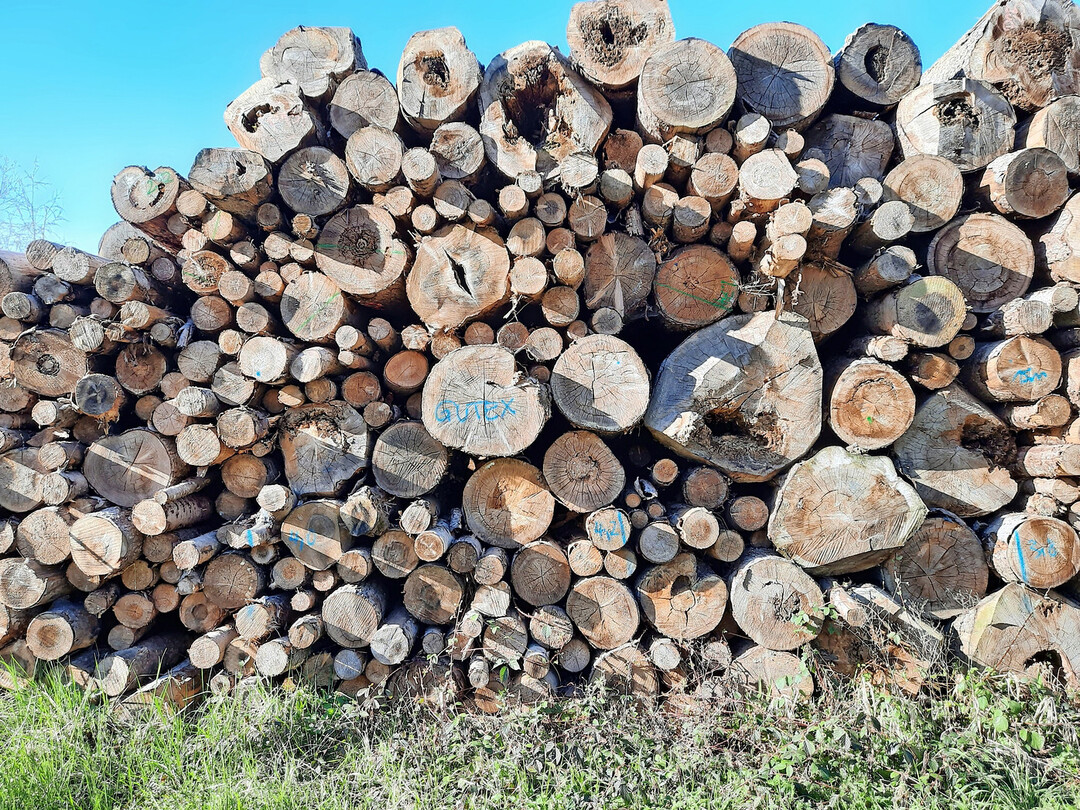
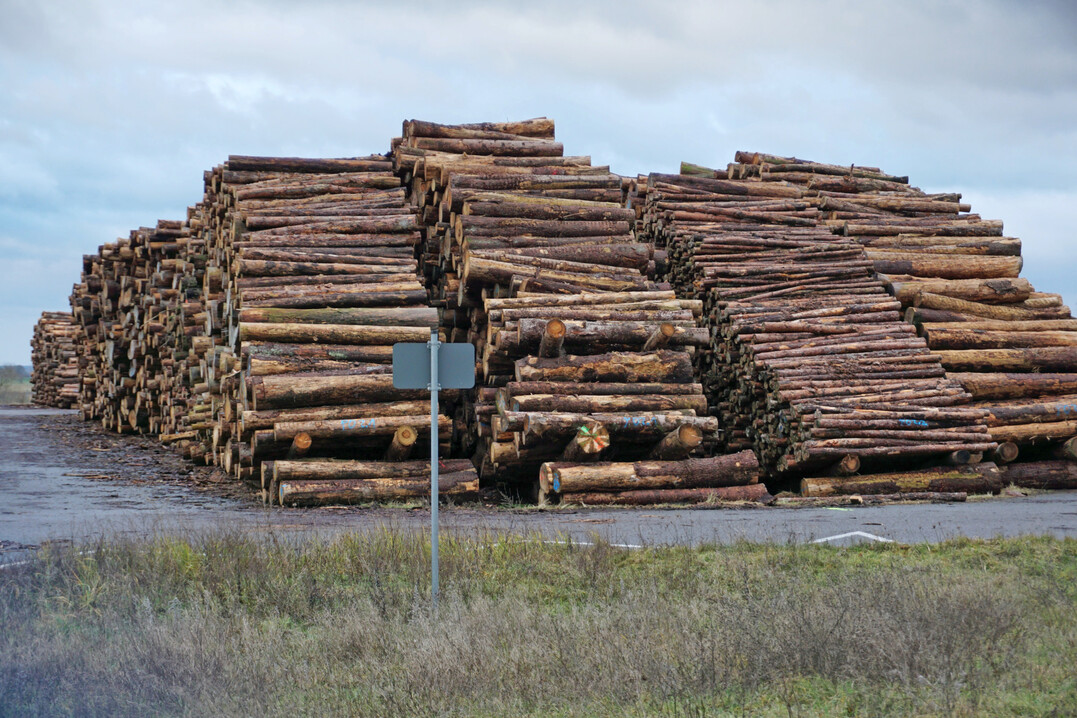
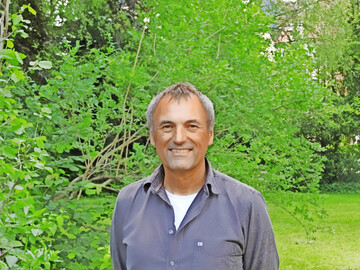


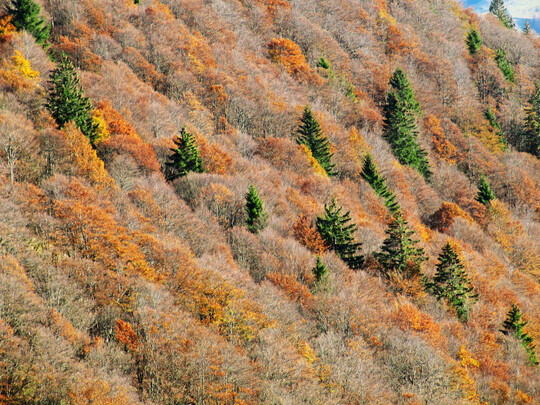
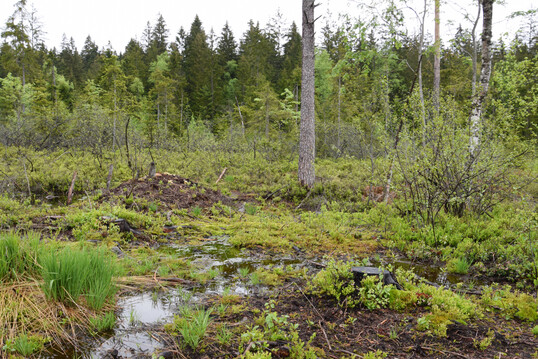

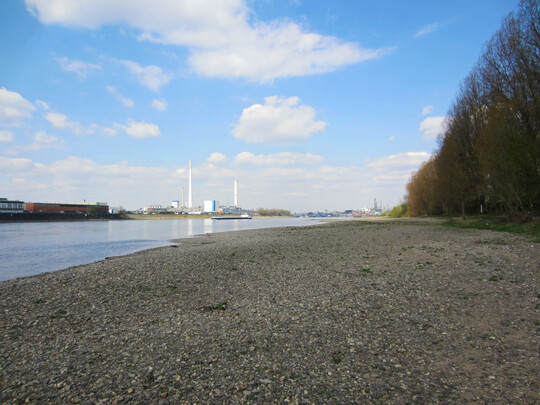
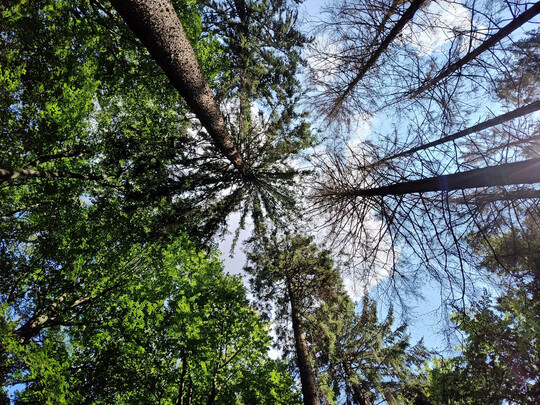

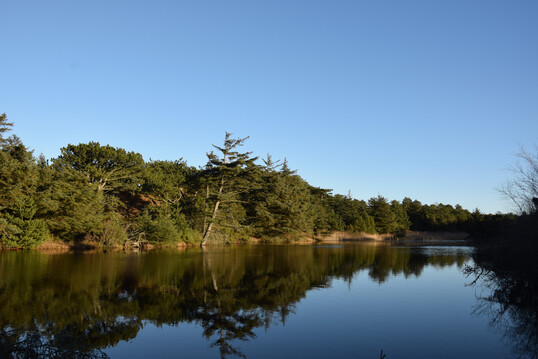
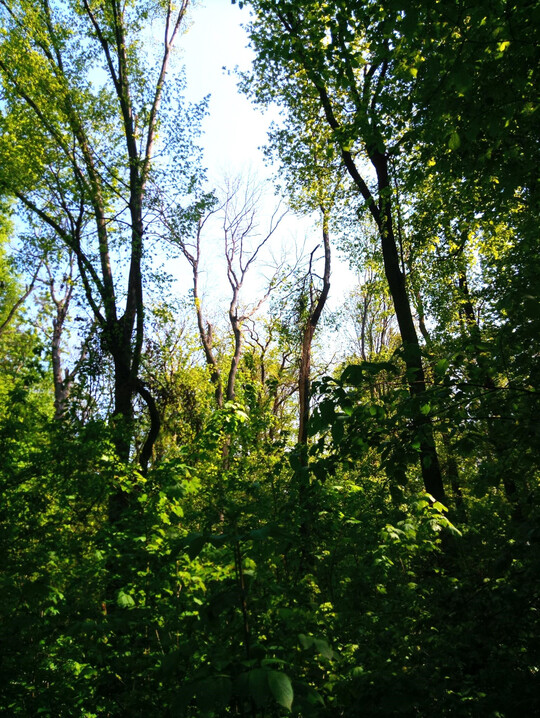
Zu diesem Artikel liegen noch keine Kommentare vor.
Artikel kommentierenSchreiben Sie den ersten Kommentar.